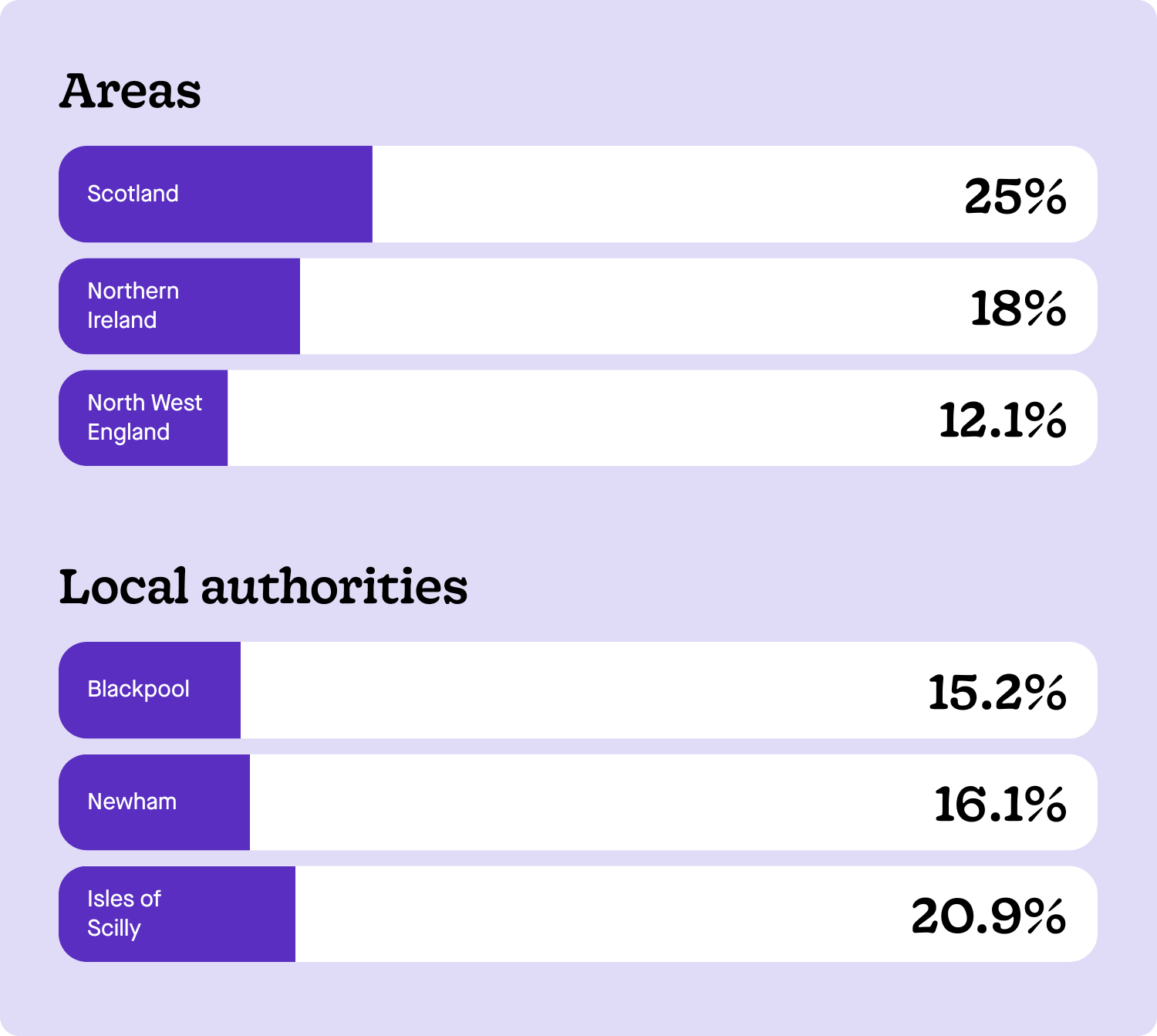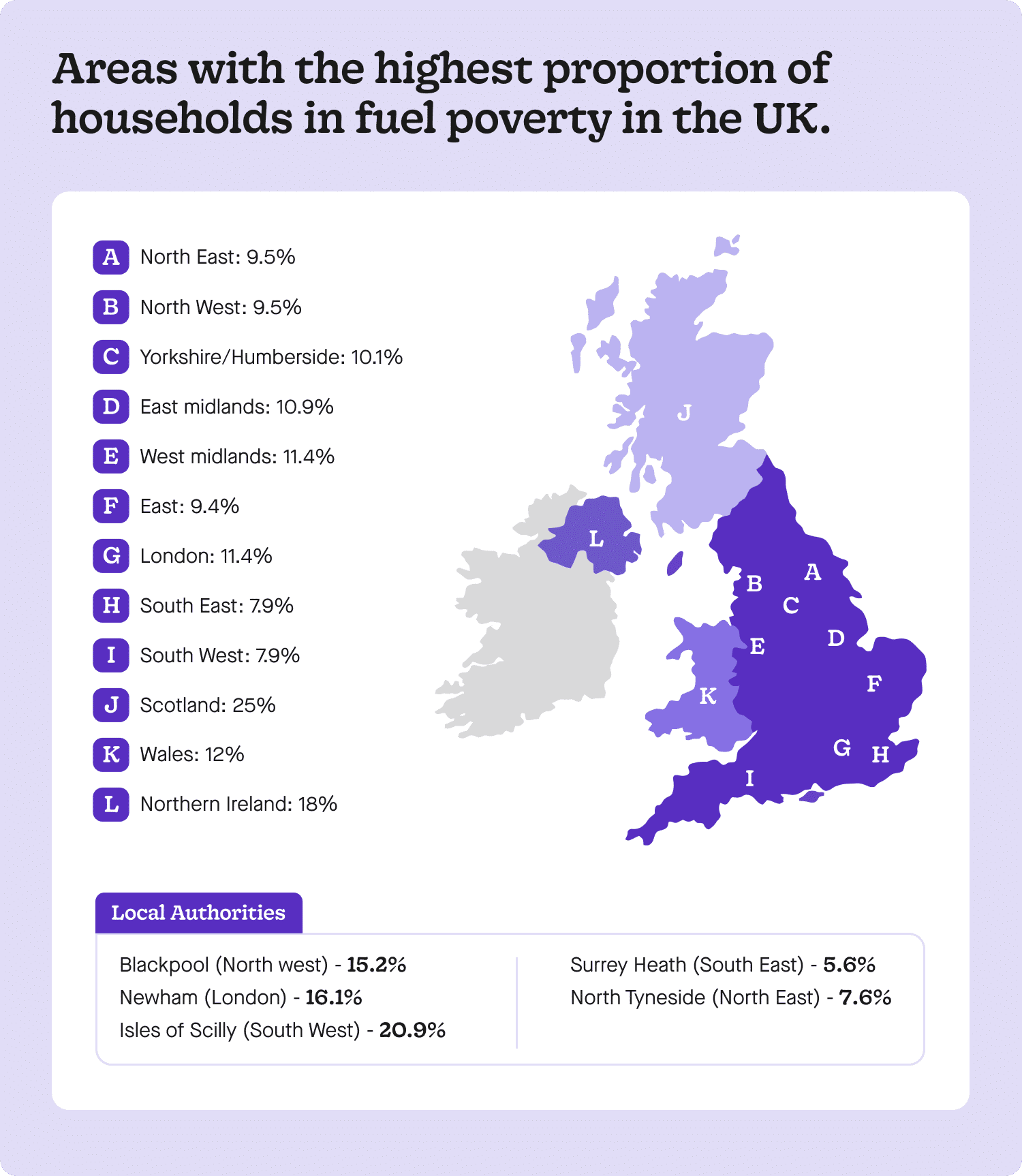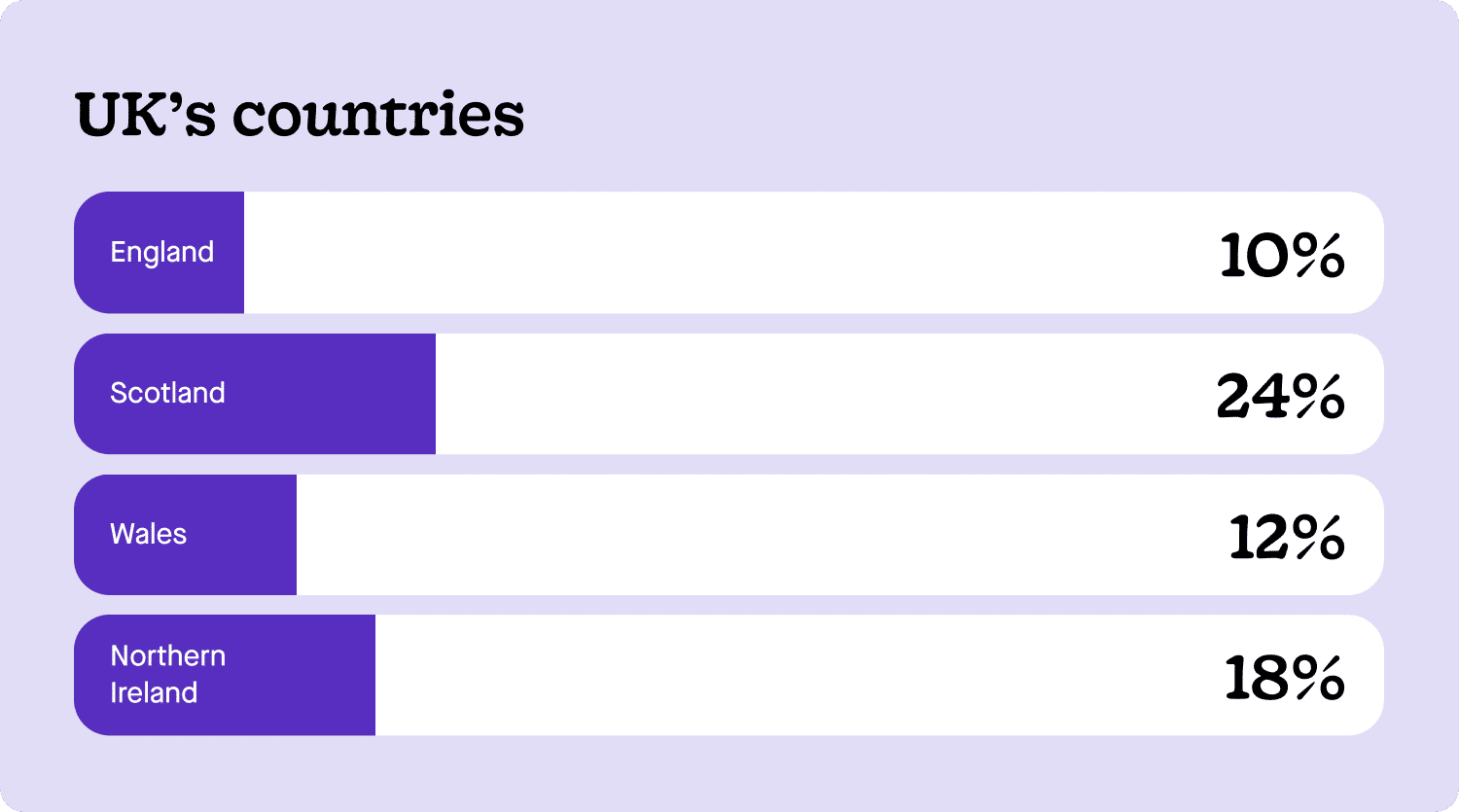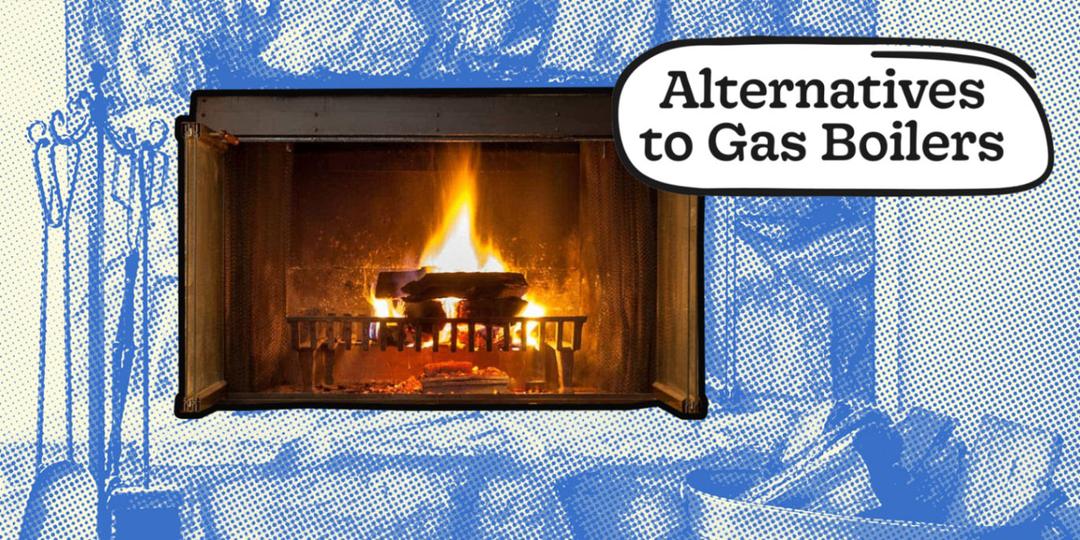Fuel poverty, plus inflation. This year has been a disastrous year for everyone, but, even more so for those under financial stress. Here, we take a deep-dive in to the numbers, and identify who's been left in the cold.
Fuel poverty affects approximately 5.5 million households (around 13–15 million people) across the UK, with numbers fluctuating due to energy price changes.
Its consequences are not just discomfort, but for many can be quite literally deadly.
The definition of fuel poverty is when a household’s required fuel costs are above the median level, and if they were to make the payments, it would leave their residual income below what is considered the poverty line.
The causes of fuel poverty include low income, increasing energy prices and poorly insulated homes.
Fuel poverty tends to predominantly affect low income households, with the least energy efficient properties who pay the most for their energy.
Due to temperatures plummeting, fuel poverty increases during the winter months. This has been further intensified by the energy crisis, which has forced those in fuel poverty to stay in their homes that they cannot afford to heat.
Unsurprisingly, some of the most deprived areas in the UK suffer from the worst rates of fuel poverty. So, which locations have the most households that are fuel poor?
We analysed the latest data to find out…
Areas with the worst fuel poverty in the UK

Scotland faces the highest rates of fuel poverty in the UK, with 31% of households (approximately 791,000) struggling to afford adequate heating, according to the 2023 Scottish House Condition Survey.
This marks a significant rise from the previously reported 25% in 2019, driven by high energy prices and rural housing challenges.
Following Scotland, Northern Ireland has a fuel poverty rate of 22% (around 170,000 households), as reported in the 2021 Northern Ireland House Condition Survey, up from 18% in 2016.
North West England follows with 14.4% of households (approximately 450,000) affected, based on 2022 DESNZ sub-regional data for England.
It’s no surprise these regions top the list, given their mix of rural locations, older housing stock, and economic pressures, which make it tough for households to keep homes warm without breaking the bank.
At the local authority level, fuel poverty hotspots include Blackpool (16.8%), Newham (17.3%), and the Isles of Scilly (21.5%), as per DESNZ’s 2024 sub-regional fuel poverty report (2022 data).
These areas face unique challenges like low incomes and energy-inefficient homes, driving up heating costs.
What about those with the least amount of fuel poverty?
Not all areas face the same struggles with fuel poverty. Surrey Heath with just 6.1% of households (approximately 2,300) classified as fuel poor.
North Tyneside, at 8.2% (around 7,800 households), is among the UK’s least affected local authorities, according to the Department for Energy Security and Net Zero’s 2024 sub-regional fuel poverty report (2022 data).
Higher incomes, newer housing stock, and better energy efficiency in these areas help keep heating costs manageable, making it easier for residents to stay warm without stretching their budgets.
Read more:
Fuel poverty by UK region (infographic)

The images on this page are licensed under Creative Commons Attribution 4.0 International (CC BY 4.0). You are free to use, share, or adapt the image, provided you attribute it by including a link to https://heatable.co.uk and noting the CC BY 4.0 license. For example: “Image courtesy of Heatable.co.uk, licensed under CC BY 4.0.
Data source:
Just how many households are in fuel poverty?

According to the Department for Energy Security and Net Zero’s Annual Fuel Poverty Statistics Report 2025 (2023 data), approximately 3.06 million households in England were in fuel poverty in 2023, a significant rise from 2.4 million in 2018.
The House of Commons Library estimates indicate that the average fuel poverty gap in England in 2023 was £417, a sharp increase from £348 in 2022 and £334 in 2018, reflecting the impact of high energy prices.
The latest estimates show that around 11% of households in England face fuel poverty, compared to 34% in Scotland, 14% in Wales, and 24% in Northern Ireland, according to the House of Commons Library’s 2025 report.
These figures highlight the ongoing challenge of keeping homes warm, especially in Scotland, where rural homes and high energy costs hit hardest.
How is fuel poverty calculated?
The exact way fuel poverty is measured varies across the UK, but the most widely used formula is in England, which is calculated using the Low-Income High Costs (LIHC) indicator.
Under the LIHC indicator, a household is considered to be in fuel poverty if the following are applicable:
They have required fuel costs that are above the national median level
If they were to spend that amount, it would leave their residual income below what is considered the poverty line
Using this information, the government is able to determine how negatively each household is and can go on to determine a household’s fuel poverty gap.
This is the amount the household will need to earn in order not to be classified as fuel-poor.
The government considers the interaction of three important factors when determining whether a household is fuel-poor:
Household income
Household energy requirements
Fuel prices
Fuel poverty in numbers - the harsh reality
In 2022/2023, the Office for National Statistics (ONS) estimated that 17,800 excess winter deaths occurred in England and Wales, a notable increase from 13,400 in 2021/2022, according to the ONS Winter Mortality Report 2024 (2022/2023 provisional data).
The End Fuel Poverty Coalition, using ONS data and Institute of Health Equity methodology, estimates that around 4,950 of these deaths (approximately 45 people per day during winter months) were caused by living in cold, damp homes, a rise from 3,186 the previous winter.
According to the ONS, those most at risk of winter mortality in 2022/2023 were females aged 85 and over, with influenza and pneumonia as the leading cause of excess deaths in England, while chronic lower respiratory diseases topped the list in Wales.
These conditions are often worsened by cold homes, putting vulnerable households in a tough spot when energy bills soar.
Energy Help Guides:
But who else is at risk?
As well as the elderly, young families are also at risk.
In fact, according to a study conducted by Economy Energy, 1 in 4 of those living in cold homes are young families with dependents.
As well as being at increased risk of certain respiratory health conditions such as asthma and bronchitis, children’s well-being and school performance are negatively affected by living in a cold home.
People who live off-grid, utilise electrical heating and have a specific need, e.g. a health condition, are at particular risk from fuel poverty.
The National Institute for Care Excellence (NICE) has a list of groups it considers most at risk from living in damp, cold conditions, These include the following:
Individuals with respiratory conditions
Individuals with cardiovascular problems
Individuals with disabilities
Individuals over the age of 65
Young children
Pregnant women
Related reading:
There are free boiler grants still available for households in receipt of certain benefits that live within the UK.
This funding is made available by the Big Six energy companies in support of assisting vulnerable households to make the transition to new, efficient boilers.
Related reading:
How can fuel poverty be tackled?
Fuel poverty can be tackled by addressing any of the factors that contribute to a household becoming fuel-poor, i.e. low income, energy requirements and fuel prices.
Since low household income is a major cause of fuel poverty, the National Energy Action is calling for the welfare system to be redesigned to help release individuals from the prison of poverty.
The Government also offer the Winter Fuel Payment, a grant to help those eligible pay for their heating bills when demand increases. However, MPS have called for this scheme to be extended to prevent a fuel poverty catastrophe.
From December of this year, energy companies are now obliged to help prepayment customers struggling to make payments, which is certainly good news for those on the breadline.
Recommended reading:
Energy switching services are a great way for households to ensure they are supplying their homes with the cheapest energy possible.
Yet, pensioners continue to face barriers when it comes to navigating the online landscape.
Home energy requirements are another key area of focus, with energy loss due to poor-quality buildings being a key target.
Instead of concentrating on the consequences of poor-quality homes, financial assistance can also be provided to help low-income households improve the energy efficiency of their homes.
For example, roof and wall insulation and double glazing make homes more thermally efficient and reduce energy loss.
In the short term, it is clear that financial assistance needs to be provided to help society's most vulnerable.
Yet, long-term, a focus on improving long-term housing in terms of energy efficiency is essential.
Poverty itself also needs to be addressed by society as a whole, which is why it is crucial to maintain pressure on MPS to ensure it receives the attention it needs.
Related reading:





